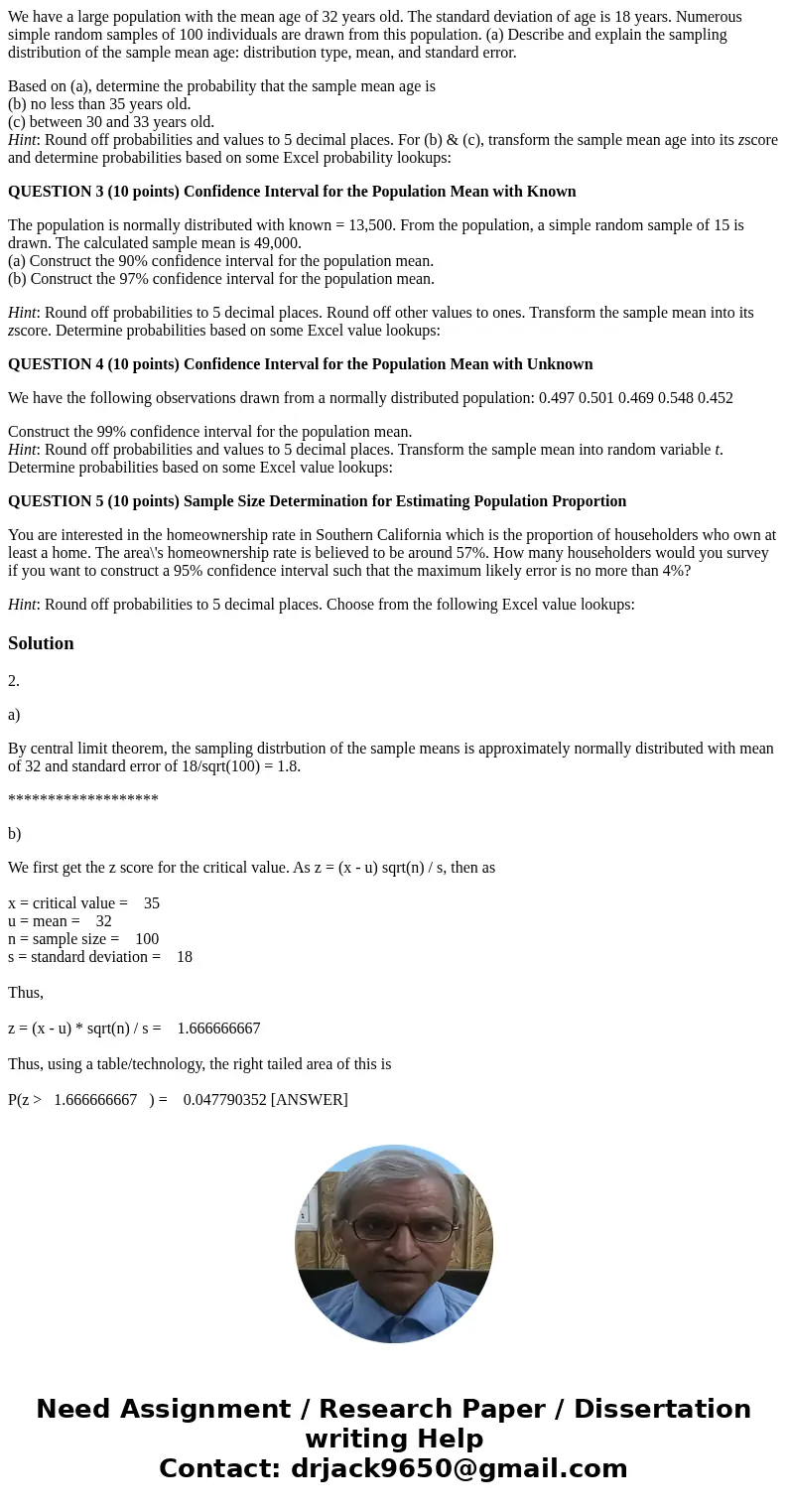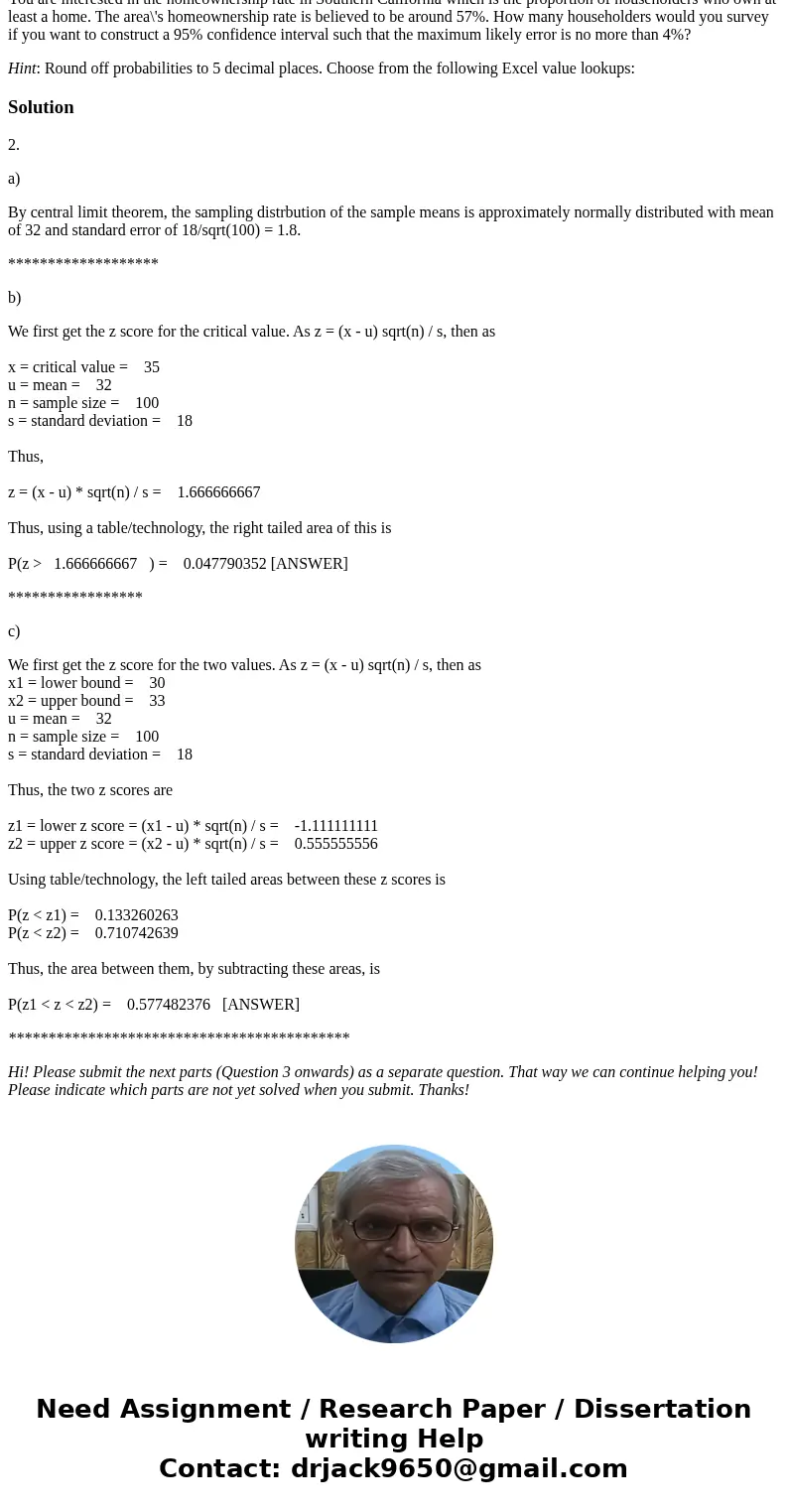We have a large population with the mean age of 32 years old
We have a large population with the mean age of 32 years old. The standard deviation of age is 18 years. Numerous simple random samples of 100 individuals are drawn from this population. (a) Describe and explain the sampling distribution of the sample mean age: distribution type, mean, and standard error.
Based on (a), determine the probability that the sample mean age is
(b) no less than 35 years old.
(c) between 30 and 33 years old.
Hint: Round off probabilities and values to 5 decimal places. For (b) & (c), transform the sample mean age into its zscore and determine probabilities based on some Excel probability lookups:
QUESTION 3 (10 points) Confidence Interval for the Population Mean with Known
The population is normally distributed with known = 13,500. From the population, a simple random sample of 15 is drawn. The calculated sample mean is 49,000.
(a) Construct the 90% confidence interval for the population mean.
(b) Construct the 97% confidence interval for the population mean.
Hint: Round off probabilities to 5 decimal places. Round off other values to ones. Transform the sample mean into its zscore. Determine probabilities based on some Excel value lookups:
QUESTION 4 (10 points) Confidence Interval for the Population Mean with Unknown
We have the following observations drawn from a normally distributed population: 0.497 0.501 0.469 0.548 0.452
Construct the 99% confidence interval for the population mean.
Hint: Round off probabilities and values to 5 decimal places. Transform the sample mean into random variable t. Determine probabilities based on some Excel value lookups:
QUESTION 5 (10 points) Sample Size Determination for Estimating Population Proportion
You are interested in the homeownership rate in Southern California which is the proportion of householders who own at least a home. The area\'s homeownership rate is believed to be around 57%. How many householders would you survey if you want to construct a 95% confidence interval such that the maximum likely error is no more than 4%?
Hint: Round off probabilities to 5 decimal places. Choose from the following Excel value lookups:
Solution
2.
a)
By central limit theorem, the sampling distrbution of the sample means is approximately normally distributed with mean of 32 and standard error of 18/sqrt(100) = 1.8.
*******************
b)
We first get the z score for the critical value. As z = (x - u) sqrt(n) / s, then as
x = critical value = 35
u = mean = 32
n = sample size = 100
s = standard deviation = 18
Thus,
z = (x - u) * sqrt(n) / s = 1.666666667
Thus, using a table/technology, the right tailed area of this is
P(z > 1.666666667 ) = 0.047790352 [ANSWER]
*****************
c)
We first get the z score for the two values. As z = (x - u) sqrt(n) / s, then as
x1 = lower bound = 30
x2 = upper bound = 33
u = mean = 32
n = sample size = 100
s = standard deviation = 18
Thus, the two z scores are
z1 = lower z score = (x1 - u) * sqrt(n) / s = -1.111111111
z2 = upper z score = (x2 - u) * sqrt(n) / s = 0.555555556
Using table/technology, the left tailed areas between these z scores is
P(z < z1) = 0.133260263
P(z < z2) = 0.710742639
Thus, the area between them, by subtracting these areas, is
P(z1 < z < z2) = 0.577482376 [ANSWER]
*******************************************
Hi! Please submit the next parts (Question 3 onwards) as a separate question. That way we can continue helping you! Please indicate which parts are not yet solved when you submit. Thanks!


 Homework Sourse
Homework Sourse